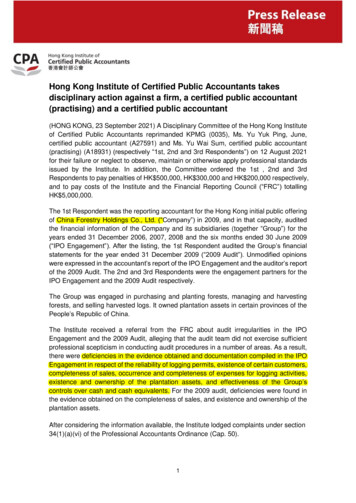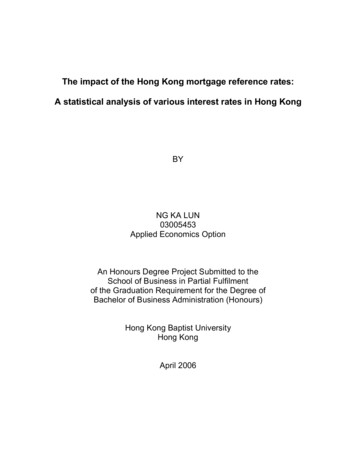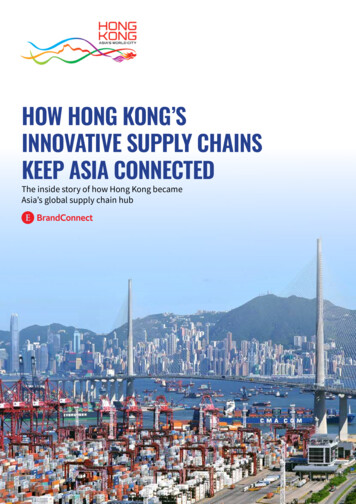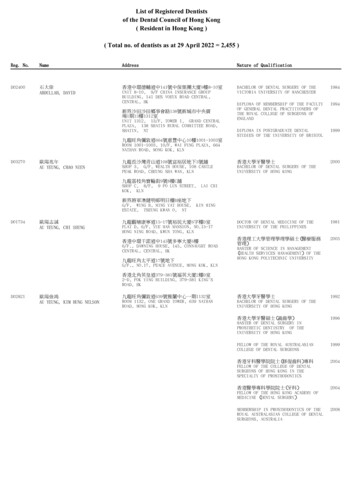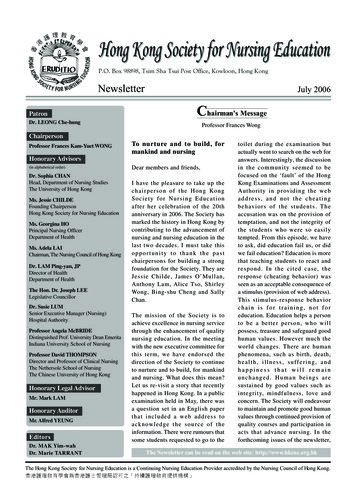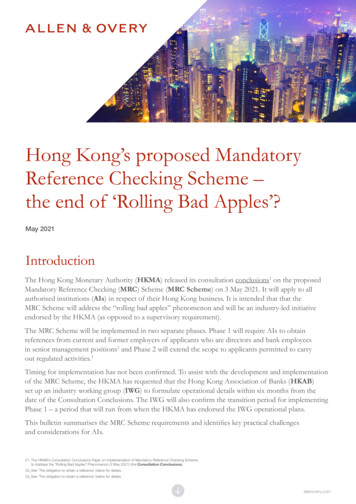
Transcription
Hong Kong’s proposed MandatoryReference Checking Scheme –the end of ‘Rolling Bad Apples’?May 2021IntroductionThe Hong Kong Monetary Authority (HKMA) released its consultation conclusions1 on the proposedMandatory Reference Checking (MRC) Scheme (MRC Scheme) on 3 May 2021. It will apply to allauthorised institutions (AIs) in respect of their Hong Kong business. It is intended that that theMRC Scheme will address the “rolling bad apples” phenomenon and will be an industry-led initiativeendorsed by the HKMA (as opposed to a supervisory requirement).The MRC Scheme will be implemented in two separate phases. Phase 1 will require AIs to obtainreferences from current and former employers of applicants who are directors and bank employeesin senior management positions2 and Phase 2 will extend the scope to applicants permitted to carryout regulated activities.3Timing for implementation has not been confirmed. To assist with the development and implementationof the MRC Scheme, the HKMA has requested that the Hong Kong Association of Banks (HKAB)set up an industry working group (IWG) to formulate operational details within six months from thedate of the Consultation Conclusions. The IWG will also confirm the transition period for implementingPhase 1 – a period that will run from when the HKMA has endorsed the IWG operational plans.This bulletin summarises the MRC Scheme requirements and identifies key practical challengesand considerations for AIs.01 The HKMA’s Consultation Conclusions Paper on Implementation of Mandatory Reference Checking Schemeto Address the “Rolling Bad Apples” Phenomenon (3 May 2021) (the Consultation Conclusions).02 See ‘The obligation to obtain a reference’ below for details.03 See ‘The obligation to obtain a reference’ below for details.allenovery.com
SummaryThe HKMA’s stated purpose of the MRC Scheme is toaddress the “rolling bad apples” phenomenon in relationto the employment of specified positions by the AIs.Under the MRC Scheme, a recruiting AI will be requiredto request a reference for prospective employees from allprior AI employers (AI Referees) over the last seven-yearperiod, irrespective of the length of employment with eachAI Referee, to facilitate its assessment and recruitmentdecision. In turn, AI Referees will be under an obligationto provide references containing: (a) information that ismaterial or serious in nature, including as to incidents thatcast serious doubts on honesty or integrity; and (b) “anyother information” that they reasonably consider relevantto the recruiting AI’s assessment of whether the individualis fit and proper.AIs will be required to put in place adequate internalsystems and controls, policies and procedures to safeguardthe information collected, used and processed in relationto the MRC Scheme.Generally, the MRC Scheme proposals are not controversial,particularly given the use of similar schemes in otherjurisdictions, such as the Senior Managers and CertificationRegime (SMCR) in the United Kingdom. However, AIReferees may face difficult decisions when establishing aframework and protocols to comply with the MRC Scheme.For example, questions may arise as to how AI Refereesshould deal with a reference request when there are ongoing(and continuing) investigations as to potential misconductinvolving the employee subject to the request, or draw aline between employee conduct and conduct within a privatelife – a line that is becoming increasingly hard to identify.We consider these and other issues that may arise whencomplying with the regime below.allenovery.com
The obligation to obtain a referenceWhen is an employee in scope?Consent of the prospective employee(a) The MRC Scheme initially identifies only a small groupof employees in respect of whom an AI will be requiredto issue a reference request, defined by their intendedrole at the recruiting AI.(a) B efore initiating a reference request, written consentshould be obtained from the prospective employee to:(i) authorise the recruiting AI to conduct reference checkingwith his/her current or former employer AIs; (ii) authorisethe AI Referees to disclose relevant employment recordsto the recruiting AI; and (iii) exempt AI Referees from anycontractual obligations that may limit their ability to discloseinformation regarding the prospective employee. In thisregard, AI Referees should ensure they comply with DataProtection Principle (DPP) 3 – Use of Personal Data underthe Personal Data (Privacy) Ordinance (Cap 486) (PDPO).See further discussion below.(i) Specifically, for Phase 1, any individual who is to performa role that requires him or her to be a director,4 a chiefexecutive,5 an alternate chief executive,6 a manager,7an executive officer8 or a responsible officer (RO)9will be subject to the scheme.(ii) T his will expand for Phase 2 as currently envisaged.In Phase 2, subject personnel will be extended to coverall staff permitted to carry out regulated activities underthe Securities and Futures Ordinance (Cap 571) (SFO),the Insurance Ordinance (Cap 41) or the MandatoryProvident Fund Schemes Ordinance (Cap 485). TheIWG will further consider including other roles underPhase 2 having regard to the experience in Phase 1.(b) G eographic limitation: The MRC Scheme will applyto AI employees in Hong Kong but not those employedat a head office, subsidiary or branch outside Hong Kong.Accordingly, there will be no requirement to seek a referencein respect of staff employed outside Hong Kong.(c) Intra-group transfers: The MRC Scheme will apply toindividuals who are moving between two AIs withinthe same group (provided the requesting AI is in HongKong). However, the HKMA has indicated that in thesecircumstances recruiting AIs can use alternative waysto conduct reference checks instead of the (the MRCInformation Template), such as by makinguse of theAI’s group internal records, common human resourcesfunctions or other means of sharing relevant information.(b) If a prospective employee refuses to provide consent, theMRC Scheme provides that a recruiting AI should considerthe reasons behind the refusal and whether it casts doubton the individual’s fitness and propriety (F&P). If therecruiting AI decides to proceed with employment withoutgoing through the MRC Scheme process, the recruitingAI should document its justifications for such exemption.(c) The MRC Information Template will indicate whetherconsent of the prospective employee has been obtained.Confidentiality agreementsAI Referees are not permitted by the terms of the MRCScheme to fail to disclose matters that would otherwise berequired to be disclosed merely because the AI Referee issubject to a contractual or other obligation of confidentiality.Accordingly, AI Referees should be careful when enteringinto any contractual obligations that may limit their abilityto disclose information as required under the MRC Scheme.This may be of particular relevance should employees departfrom an AI following a grievance that has been settled underterms containing strict confidentiality. Both recruiting AIs andAI Referees should seek written consent of the individual toexclude their disclosure obligations under the MRC Schemefrom any contractual obligations that may otherwise limittheir ability to disclose the necessary information, althoughthis may not be straightforward in respect of departedemployees. Without this, AIs may find themselves innon-compliance with the MRC Scheme.04 Approved under section 71 of the Banking Ordinance (Cap 155) (BO).05 Approved under section 71 of the BO.06 Approved under section 71 of the BO.07 Notified to the HKMA under section 72B of the BO.08 Approved under section 71C of the BO.09 Approved by the Insurance Authority under section 64ZE of the Insurance Ordinance (Cap 41),or approved by the Mandatory Provident Fund Schemes Authority (MPFA) under section 34Wof the Mandatory Provident Fund Schemes Ordinance (Cap 485).allenovery.com
Matters to be included in the referenceFor consistency across the industry, the HKMA has createdan MRC Information Template (which the IWG will finaliseduring the course of the next few months) to be completedby AI Referees.The MRC Information Template sets out questions expectedto be asked in each case and to which the AI Referee isrequired to respond.The MRC Information Template requires an AI Refereeto provide basic employee information, includingconfirmation of an individual’s name, ID/passport number,details of the relevant position(s) held, name of business/function, department, period of employment, and reasonfor cessation of appointment.It also contains requests to which AI Referees may find itmore difficult to respond due to breadth and lack of clarity.For example:– “Incidents which cast serious doubts on honesty,integrity or matters of similar nature”.It will be for the AI Referees to decide whether theyconsider any misconduct that occurred is “serious”enough to warrant inclusion in this regard, leaving asignificant amount of discretion. AIs may like to considerguidance under the SMCR in this regard, which providesa number of factors that referees should take intoaccount when determining if misconduct is “serious”.These include: (a) whether the individual has committeda serious breach of a code of conduct, whether thebreach was dishonest, deliberate or reckless, thefrequency of breach, and the extent of loss; and (b)whether the individual’s conduct caused the firm tobreach a regulatory requirement. It will be interesting tosee whether the IWG also has regard to these factorswhen it considers the MRC Information Template overthe coming months.– “Internal or external disciplinary actions arising fromconduct matters”.According to the HKMA, “internal disciplinary actions”include actions that are taken by the AI against theemployee as a result of misconduct on the part of theemployee. It may include internal warnings, financialpenalty involving remuneration, and suspension anddismissal due to misconduct. It does not includemanagerial coaching and counselling, suspensionpending investigation, leave taken while investigationsare being carried out, or investigations that do not resultin adverse findings.– “Any other information” that an AI Referee reasonablyconsiders “relevant to the [recruiting AI’s] assessment of theconduct of the individual, i.e. their fitness and propriety”.The HKMA has clarified that such information be relatedto “misconduct that is of a material or serious nature”.A similar “catch all” appears in SMCR, where the requirementis to provide “any other information that the [firm] reasonablyconsiders to be relevant to the requesting firm’s assessmentas to whether the individual is fit and proper”.Firms inevitably have a significant degree of discretion asto what they include within the scope of this category.One way to think about whether or not to include informationabout an individual is for the AI Referee to consider whetherit would expect to be notified of that information if it werehiring the individual in question and having to approve himor her as fit and proper to perform his or her future role.Further guidance on these categories of information maybe provided via the IWG in due course.Easier said than done?Regardless of the form of the questions, the MRC Schemeis likely to give rise to challenges when assessing whatinformation is within (or might be within) scope. Some areasof possible challenge are addressed below.(a) Ongoing investigationsThe HKMA expects that the information provided underthe MRC Scheme will be “true, fair, complete, accurate andcapable of substantiation”. Reference-providing AI Refereesshould therefore not withhold information that may otherwiserender the reference incomplete, inaccurate or misleading.However, it may be particularly difficult to satisfy thisobligation should an employee that is subject to a requestbe mid-way through a misconduct investigation ordisciplinary process.The HKMA considers that the reference providing AIshould nevertheless provide information regarding ongoinginvestigations with serious allegations as well as thosethat are about to conclude with disciplinary action.To do otherwise could create a loophole within the regime.The HKMA’s objective is to strike a balance betweenmanaging an AI’s litigation risk and the risk of hiring badapples. Disclosure might include basics of the investigationand its status, following which the recruiting AI may pickup the conversation with the employee.This could be seen as a more strict approach than thattaken in other jurisdictions. For example, the UK’s BankingStandards Board’s (BSB) statement of good practice advisesthat when an employee leaves before a full disciplinaryprocess can be completed, information about alleged poorconduct should generally be considered unverified, hence notrequired to be disclosed unless the evidence of wrongdoingin relation to an employee is such that it would havebeen pursued through further investigation or disciplinaryproceedings; the latter information should be included.The HKMA acknowledges that the IWG should considerthis area of disclosure and consider producing guidance onthe types of ongoing investigations that should be includedand exemptions that should be applied. It is expectedthat the IWG will do so based on HKMA’s views and fromindustry feedback.allenovery.com
(b) The relevance of private conduct and behaviourF&P is defined in the SFO11 and the SFC’s Fit and ProperGuidelines include references to an individual’s: (a) financialstatus or solvency; (b) educational or other qualificationsor experience; (c) ability to carry on the regulated activitycompetently, honestly and fairly; and (d) reputation,character, reliability and financial integrity.Certain private conduct and behaviour is, therefore,clearly relevant to an assessment of an individual’s F&P,such as conduct of a criminal nature even if it occurs inthe individual’s private life.Similarly, FCA guidance asks firms to consider whetheran individual has been convicted of a criminal offence, inparticular, offences of dishonesty, fraud, financial crime,market manipulation and insider dealing, or offences undercertain company and business legislation, as a factor thatmay be relevant to his or her F&P.12However, there may be less obvious matters of privateconduct such as discrimination, bullying and harassment.The FCA has made it clear that these are relevant mattersunder the SMCR.13 The HKMA appears to take a similarposition, stating in its Consultation Conclusions that “sexualharassment or bullying should be considered misconductactivities and should be included as reportable mattersunder the scope of MRC”.14More difficult assessments may arise should, for example,an employee make what is ostensibly a political commentin public or on social media but one that is later subjectto criminal investigation by relevant authorities.In addition, quite how an AI must assess the relevance ofprivate conduct to an F&P assessment is unclear. In therecent case Beckwith v Solicitors Regulation Authority[2020] EWHC 3231 (Admin), the English High Courtconsidered how an institution should assess the impactthat events that take place in an individual’s private lifemay have on his or her professional standing in thefollowing terms:“[The applicable rules] may reach into private life only whenconduct that is part of a person’s private life realisticallytouches on [their] practise of the profession or thestanding of the profession. Any such conduct must bequalitatively relevant Regulators will do well to recognisethat it is all too easy to be dogmatic without knowing it;popular outcry is not proof that a particular set of eventsgives rise to any matter falling within a regulator’s remit”(paragraph 54).More recently, the FCA has assessed the relevance ofan offence arising out of the private conduct of a financialadviser by considering the fact that the regulated individualwas “in a position of trust as regards his customers,who rely on his advice when making significant financialdecisions and need to be able to trust that he will actappropriately” and also explained that “in order to maintainpublic confidence in the financial services industry, the[FCA] and the public are entitled to expect that approvedpersons and financial advisers are individuals with integrityand good reputation”. Even though the offence concernedwas not committed at work and did not involve financialdishonesty, the FCA found that it involved the individual“deviating from legal and ethical standards and seekingto exploit those more vulnerable than himself, which in the[FCA’s] view is fundamentally incompatible with his roleas a financial adviser”.We expect the HKMA will apply the regime in a mannerthat upholds public policy and market integrity at the heartof its responsibilities, although whether the HKMA will takea similar stance to the assessment remains to be seen.(c) Privilege and statutory secrecyThe Consultation Conclusions do not expresslyacknowledge that privileged information need not andshould not be disclosed in MRC Scheme references.Nonetheless, an entity, including a reference-providingAI, is entitled to resist disclosure of privileged informationunder the common law.Similarly, although the HKMA has not expressed aview as to whether statutory secrecy is an excuse fornot disclosing information in the reference, an AIReferee should nevertheless preserve secrecy relatingto matters subject to an SFC or HKMA investigationwhen providing disclosure of information through theMRC Scheme.An opportunity to be heardIn the event that negative information is received fromAI Referees, the recruiting AI should provide the prospectiveemployee with an opportunity to be heard, both as a matterof fairness, and also taking into consideration PDPO rightsto request correction of personal data.15It is of course possible that an AI Referee may chooseto discuss the facts to be disclosed in its response withthe subject employee, before sending its response to therequesting AI. It is worth noting that in those circumstances,in the UK an employee’s “opportunity to comment” oninformation in a reference does not mean “the firm shouldprovide an opportunity [to the employee] to comment onthe reference itself, as opposed to the allegations on whichit is based”. The FCA has said that a firm “should take thoseviews into account so far as appropriate when decidingwhether something should be disclosed and how thedisclosure is drafted”.16While this view has not been expressed by the HKMA,it would seem to be a reasonable and fair approach toadopt with respect to the MRC Scheme.11 Section 129.12 FIT 2.1.3G.13 k/publication/correspondence/wec-letter.pdf; and enge-to-be-met.14 The Consultation Conclusions, page 27, item number 2015 PDPO section 22; DPP 6 – Data Access and Correction.16 .html?date 2021-01-05.allenovery.com
TimingsReporting timeframe covered by the MRC SchemeTime to initiate the MRC Scheme processIn Phase 1, the recruiting AI should approach all formerand current employers (which are AIs) of the prospectiveemployee for employment records in the past seven yearsfrom the date of request.17 This is in contrast to the HKMA’soriginal proposed timeframe of ten years.The HKMA has advised that the recruiting AI may consultwith the prospective employee as to when within therecruitment process the MRC request should be sent tothe AI Referees. The HKMA suggests adopting a “staggeredapproach” so that the recruiting AI can proceed to conductMRC with former employers first and the current employerlater, after the prospective employee has tendered his/herresignation. The recruiting AI should then extend written MRCinformation requests to the AI Referees, indicating clearly thatthe prospective employee’s consent has been obtained toperform reference checking under the MRC Scheme.As a result, all AI Referees should maintain employmentrecords of their employees who have ceased to beemployed by the AI Referees for a period of at least sevenyears from the date of the employees’ departure.Recognising that not all AI Referees will have retainedrelevant records for a seven-year period beforeimplementation of the MRC Scheme, the HKMA has statedthat the IWG will work out suitable transitional arrangementsor grace periods for AI Referees in relation to past or currentemployees about whom the AI may subsequently receivean MRC reference request.Timeframe for providing a referenceAn AI Referee should provide a response within one monthfrom the date of the MRC request. This is an increase fromthe original proposal of ten working days, but is shorter thanthe UK where the period is six weeks following receipt.AI Referees will need to ensure that the internal recordkeeping and processes allow for this, especially whereprovision of a reference involves discussion with variousinternal stakeholders such as past line managers, HR ordisciplinary committees.If the AI Referee is going to find it difficult to provide areference in the allotted time it should provide an interimresponse and indication of when the full MRC referencewill be provided.Using the information receivedAn MRC Scheme reference should be used in the recruitingAI’s assessment of that individual’s F&P to undertake therole for which they are to be hired. The HKMA is clear thatin the event that a reference contains negative information,recruiting AI Referees will need to consider the likelihood ofthe prospective employee committing misconduct in thenew working environment. The BSB provides similar butmore expansive guidance for the SMCR regime, noting thatfirms should seek to make balanced decisions about hiringan individual whose regulatory reference discloses negativeinformation, rather than using the regulatory reference asa binary screening tool. Such a decision should considerfactors such as the seriousness of the information providedand the risk tolerance of HR and the business area.The recruiting AI is entitled to follow up where necessarywith the AI Referees for clarification and further informationif this would assist its recruitment considerations.The HKMA has made clear that an AI Referee shouldrespond to follow-up questions to facilitate the recruitingAI’s reference checking processes as far as practicable,unless the information may reveal confidential and proprietaryinformation about its business and employees other than thecandidate, or commercially sensitive information.The recruiting AI will have discharged its obligations if it hasreasonably followed up but the AI Referee has refused toprovide answers.17 The SCMR’s period is six years.allenovery.com
The obligation to update the referenceAn AI Referee is required to provide an update to therecruiting AI on any investigation or proceeding that: (a) iscommenced within seven years after the individual has leftthe AI Referee; and (b) concluded that the individual was guiltyof misconduct or was involved in any misconduct incidents.It must provide that update within one month of conclusionof the matter.In the UK, the FCA has also introduced an obligation toupdate regulatory references already provided if the firmbecomes aware of matters or circumstances that would haverequired it to draft the original regulatory reference differentlyhad the information been known at the time. This obligationextends up to six years after the relevant individual wasemployed by the firm providing the reference.In addition, an MRC update should be provided where theinformation in the update would lead to substantive changesto the reference information previously provided.The HKMA is silent on how long the obligation to provide anupdate will remain, but consistent with the MRC Scheme timeframe, seven years would be appropriate.Moreover, the HKMA has suggested that when respondingto the MRC Information Template, AI Referees may alsoindicate whether they expect to provide an update in thefuture, with an approximate indication on when this might be.The recruiting AI Referee will then be on notice to approachthe AI Referee for an update if needed.The HKMA does not provide any guidance on whether theAI Referee should provide the individual with an opportunityto comment on the updated reference. However, consistentwith UK practice, an AI Referee may wish to discuss thefacts to be disclosed with the subject employee. If the subjectemployee denies or comments on the facts to be provided,the AI Referee can mitigate litigation risk by expressly statingthe employee’s position in the MRC Reference.Limiting liabilityGiven the purpose of the MRC Scheme, AI Referees shouldbe mindful of litigation risk when providing a response to theMRC Scheme. The HKMA has, however, sought to mitigatethis risk through various measures within the Scheme.First, the HKMA requires that any reference should betrue, accurate, fair and not misleading to the best of theAI Referee’s knowledge. Matters that an AI has not beenable to identify notwithstanding adequate systems andcontrols and enquiry should fall outside that obligation.Second, the MRC Information Template includes a disclaimer.This provides that the recruiting AI takes full responsibility inrelying on the information provided in the template in makingits recruitment decision, and that the AI Referee is excludedfrom liability in the absence of negligence and bad faith.It appears there is no prohibition on AI Referees drafting theirown disclaimers to make them more comprehensive shouldthey wish.The MRC Scheme also expects the recruiting AI to assessthe individual’s F&P and make a recruitment decision in itsown discretion. In those circumstances, it would be difficultfor the recruiting AI to hold the AI Referee liable in theabsence of negligence and bad faith.Regardless of these measures, AI Referees should of courseassess employees’ conduct in a consistent and fair manner,and maintain adequate records to allow them to do so,in order to further mitigate litigation risk.The MRC Scheme is silent as to whether an AI Refereeshould discuss the facts to be disclosed with the subjectemployee before the reference is returned, allowing theAI Referee to record the employee’s comments in thereference. That is the practice in the UK. The HKMA’s viewis rather that the recruiting AI should provide the prospectiveemployee with an opportunity to be heard in the event thatit receives negative information from AI Referees. AI Refereesmay wish to adopt the approach in the UK to furthermitigate litigation risk.allenovery.com
Systems and controlsPolicyAI Referees should put in place adequate internal systemsand controls, policies and procedures to safeguard theintegrity and confidentiality of information obtained andprocessed during the MRC process.Moreover, AI Referees should reconsider their employeePersonal Information Collection Statement (PICS) (whetherin the employment contract or elsewhere) to ensure theyare fit for personal data collection under the MRC Scheme.Specifically, AI Referees are expressly required to ensurethat prospective employees are informed of the matters inrelation to the collection of their personal data under theMRC Scheme, such as the purpose for which the data isto be used, the details of data that will be collected, howthe data collected will be used, and how the data will betransferred to recruiting AI Referees for reference checkingunder the MRC Scheme.AI Referees should note that, under DPP6 and section 22of the PDPO, prospective employees are given the right torequest a copy of their personal data, which will includedata obtained as part of the MRC Scheme.In addition, all AI Referees should implement measures andhave policies and procedures in place to ensure that they cancomply with a data correction access as well as requestsmade by a job applicant, current or former employee.Record keeping(a) T he MRC Scheme reinforces the need for AI Refereesto maintain sufficient records to support their compliancewith the MRC Scheme – whether as a recruiting AI or anAI Referee.(b) As discussed above, all AI Referees should maintainemployment records of their former employees for a periodof at least seven years counting from the date of cessationof employment.Fairness and alignment with the PDPOUnder DPP2(2), all practicable steps must be taken toensure that personal data shall not be retained longer thanis necessary for the fulfilment of the stated purposes.Generally, an employer should implement a written dataretention policy that specifies a retention period of no longerthan seven years in respect of employment-related data fromthe date the employee leaves employment, unless there isa subsisting reason that obliges the employer to retain thedata for a longer period or the former employee has givenprescribed consent for the data to be retained beyondseven years.Given that the stated purpose of the MRC Scheme is toenhance the integrity of the banking industry, the PCPDgenerally considers it as a subsisting reason and in the publicinterest for the employer to retain the data for a longer period.Having said that, the PCPD considers that it would be fair ifthe employees are given a right to request deletion of theirdata in specified circumstances, for example retirementand permanent departure from Hong Kong. Under thesecircumstances, it would no longer be necessary for theemployers to retain the personal data of those employees.18Recruiting AIs should not retain the personal data of anunsuccessful job applicant for a period longer than twoyears from the date of rejecting the applicant, unless thereare special circumstances that are clearly documented.18 The Consultat
The Hong Kong Monetary Authority (HKMA) released its consultation conclusions1 on the proposed Mandatory Reference Checking (MRC) Scheme (MRC Scheme) on 3 May 2021.It will apply to all authorised institutions (AIs) in respect of their Hong Kong business.It is intended that that the MRC Scheme will address the "rolling bad apples" phenomenon and will be an industry-led initiative

